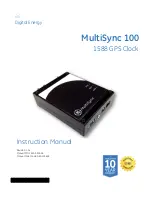
UBX-G7020 - Hardware Integration Manual
Design-in
GPS.G7-HW-10003
Objective Specification
Page 26 of 74
2.4.2
Crystal or TCXO package selection
Of course, the package of the crystal or TCXO can be freely chosen. However, the general rule applies that
smaller packages make it more difficult to manufacture good GPS crystals. Smaller packages also have a smaller
thermal mass, making them more sensitive to thermally induced frequency perturbations. SMD packages usually
have a low thermal resistance to the circuit board. Temperature changes of the board, e.g. due to variation in
power consumption of the UBX-G7020 or other adjacent components, may directly affect crystal/TCXO
temperature. Through-hole mounted crystals are better isolated from these effects.
2.4.3
Frequency perturbations
Frequency perturbations, i.e. small frequency errors typically induced by temperature changes or changes in the
drive level, will have a significant effect on GPS/GNSS performance. While the normal smooth dependency of the
crystal frequency on temperature and drive level is easily compensated by GPS/GNSS firmware, a sudden
discontinuity cannot be compensated for. If such perturbations occur the receiver will not be able to maintain
carrier lock and will be unable to demodulate data from the satellite signal. Hence the receiver will never be able
to calculate a position unless it is used with Assisted-GPS/GNSS.
Besides environmental influences such as forced air convection, poor quality of the crystal oscillator is the main
source for such perturbation problems.
The GPS Crystal/TCXO must be isolated from external temperature changes as well as possible. Forced
air convection currents must never reach the crystal/TCXO. Temperature changes of the circuit board
and thermal cycling of the system should be kept to an absolute minimum. This even holds for a TCXO
because its temperature compensation feedback loop is unable to track rapid temperature changes.
Poor quality of the crystal results in excitation of unwanted oscillation modes. There are many different types of
modes that can be excited during resonance apart from the desired thickness shear mode. Coupled modes,
often referred to as “activity dips”, occur when two or more excited modes, or normally their harmonics, beat
together. Face-shear, flexure, thickness-twist and many other modes with their respective harmonics, can couple
into the main mode at a particular temperature and reduce the Q-factor and selectivity of the crystal - hence the
term “activity dip”. Accompanying the activity dip is a frequency deviation from the smooth temperature
characteristic curve. As well as a large frequency change, the resistance change can prevent oscillation in
extreme cases. These dips are much more common with fundamental frequency modes and where the diameter
or size of the crystal is small.
Crystal manufacturers can minimize the occurrence of these dips by optimizing the crystal design, however to
eliminate them in production is virtually impossible. Even the best crystal designs will leave some percentage of
units with dips. To ensure crystals with unwanted modes are not released requires individual unit testing. Testing
the units in an environmental chamber over the operating temperature range and looking for frequency
perturbations is the most effective method. Some activity dips can occur over a very narrow temperature span
and will produce the worst effect. Hence the measurement resolution of the screening system is of prime
importance as dips can be easily missed.
It is extremely important that the crystal does not cause any sudden jumps in phase or frequency when used in a
GPS/GNSS oscillator circuit. If they occur, these frequency perturbations will cause velocity errors initially and
ultimately tracking lock loss.
It has been shown that insufficient cleaning of the crystal, surface voids, or badly placed electrodes are the chief
causes of poor crystal performance.
When selecting a supplier for GPS/GNSS TCXOs or crystals, one should make sure that the supplier is
aware of the requirements of the GPS/GNSS application. Specifically, the supplier should be able to offer
a screening process targeted at elimination of activity dips or frequency perturbations with a sufficiently
fine temperature step.
Crystals and TCXOs listed in Sections 3.1 and 3.2 have been found to work well in GPS/GNSS applications.
Confidential
















































